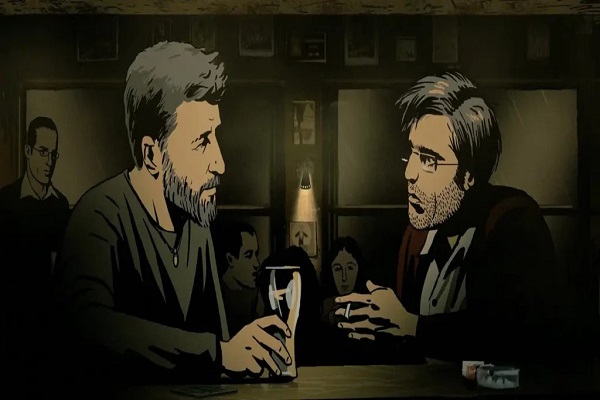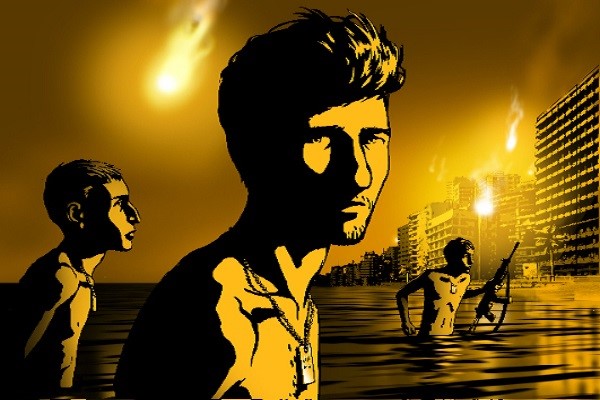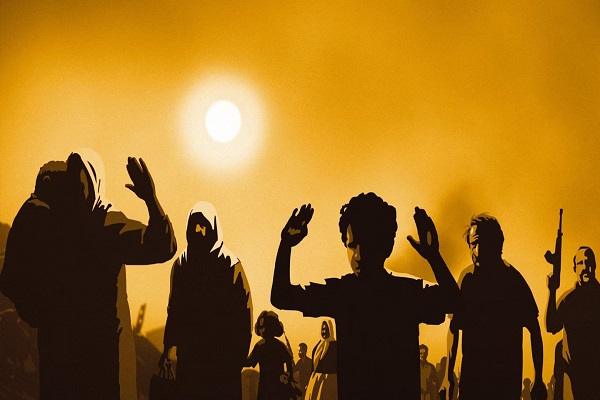Israeli filmmaker Ari Folman’s animated war documentary Waltz with Bashir is one of the most important and heartbreaking films ever. Through this film, Folman brings back the horrendous memories of the Sabra and Shatila massacre. His choice of animation over live action gave him complete freedom and flexibility while making this film. When Folman meets with his friend Boaz, he tells him about his recurring nightmare of the twenty-six dogs whom he killed during the 1982 Lebanon War chasing him to his house. Boaz, still, remembers each one of them, in every little face, every wounded look in their eyes, and every cry of pain. However, Folman can’t remember anything about the war, even though he also took part in it. As per the advice of his therapist friend, he starts interviewing the witnesses of the war to reconstruct his memories. Even though Folman digs deeper into the 1982 Lebanon War through Waltz with Bashir, it is not a political film. He vividly shows through this film how Christian Phalangists brutally carried out the genocide of the innocent Palestinians inside the Sabra and Shatila refugee camp in the name of terrorist elimination amid the full protection and awareness of the Israeli forces. Folman’s conscience haunts him as he was totally unaware of the massacre, even though he was only a few hundred yards away from the camp.

In Waltz with Bashir, director Ari Folman interviews multiple eyewitnesses of the Sabra and Shatila massacre to reconstruct his memories of the 1982 Lebanon War in which he took part. Under the full protection and awareness of Israeli forces, Christian Phalangists carried out this brutal massacre by murdering more than three thousand innocent Palestinians. Israeli forces helped them by firing flares throughout the night of 16th September 1982. The head office of the Israeli Defense Forces (IDF) in Beirut was situated in a tall building just a few hundred yards away from the camp. So, the Israeli forces did not do anything to stop the massacre. The Phalangists avenged President-elect Bashir Gemayel’s death by lining up the innocent Palestinians, including elderly people, women, and children, and killing them at point-blank range. The alleys of the Sabra and Shatila camps were full of dead bodies up to the height of a young man’s chest. Israeli journalist Ron Ben-Yishai found the dead body of a very young girl with curly hair. Her face and fingers were vividly visible amid the rubble. Heartbreaking cries of Palestinian women made the air heavy. The Phalangists were so ruthless that many of them stored different body parts like eyeballs, fingers of Palestinians in formaldehyde. Crucifixes were curved on their chests. Folman stayed just a few hundred yards away from this horrendous genocide.
Even though Ari Folman was not directly involved in the massacre and stayed in the 2nd or 3rd circle of the Israeli forces, there is no denying the fact that he helped the Phalangists unknowingly by firing the flares. This guilty feeling made him restless, and he interviewed the eyewitnesses to establish the truth. His desperation to seek and establish the real facts about the 1982 Lebanon War resulted in Waltz with Bashir. Through this film, he vividly shows the world, especially the young audiences, that a war doesn’t do any good to anybody. It only creates bloodbaths and massacres. Some filmmakers glorify wars by making heroic depictions of the characters, which is extremely dangerous and deplorable. His simple point is that wars are useless.

Even though Folman claims Waltz with Bashir is a complete non-political film, the question remains whether he plays an apologist for Israel through this film. He argues that had it been a political film, he would have interviewed the Palestinians and the Phalangists. As per Folman, it is a deeply personal film to bring up the true events and not to glorify the war or play an apologist in favor of Israel. Through this film, he comes to terms with his conscience. Even though Waltz with Bashir was well received in Israel, it was heavily criticized in the Arab countries.
Not only the commanders of the Israeli forces, but the then defense minister of Israel, Ariel Sharon, was also fully aware of this horrendous Sabra and Shatila massacre. Multiple sources have revealed over time that Sharon himself charted out the plan of this massacre at least two months back, which was executed by the Phalangists with the protection of the multi-layered Israeli forces. When journalist Ron Ben-Yishai informed him about the massacre, he casually asked him if he had seen this and then wished him a happy New Year and went to sleep. Unfortunately, people who could have stopped this bloodbath did absolutely nothing to stop it. After the mass demonstration of more than three million Israeli citizens, the then Israeli government was forced to set up the Kahan Commission to look into this matter. Sharon was found indirectly responsible for this massacre, and he was sacked. However, the same Ariel Sharon became the Prime Minister of Israel in 2001.
Waltz with Bashir is also about dreams, nightmares, and hallucinations. We don’t forget the most traumatic experiences, and those incidents keep haunting us throughout our lives. They keep appearing in our lives as nightmares and hallucinations. The twenty-six dogs that Ari’s friend Boaz killed in the 1982 Lebanon War have been chasing him toward his house for the past twenty years in his nightmare. Even though Ari has forgotten almost everything about the 1982 Lebanon War, he keeps hallucinating the same scene wherein the naked soldiers are coming out of the sea while the Beirut skyline is being illuminated by the flares fired by IDF soldiers. In another dream sequence, Folman is saved by a naked woman who swims across the sea, taking him along with her when their ‘love boat’ is bombed by an enemy airplane.

Lack of actual footage of the incident and the unwillingness of a few key eyewitnesses to be interviewed made Folman choose animation over live action for making Waltz with Bashir. At first, he shot the film in live action mode, and then the footage was turned into animation at four thousand frames per second using flash animation, classic animation, and 3D technologies. Out of nine interviews, Folman used actors only for two, and the remaining seven interviews were of the real eyewitnesses. The usage of animation gave Folman the complete freedom and flexibility to portray the real facts in the film. However, the film ends with the short but real newsreel footage of the massacre and the heartbreaking cries of the innocent Palestinian women.
A photographer, described by Post-trauma expert Prof. Zahava Solomon to Ari Folman, freaked out when his camera broke and he saw the real pictures of the war. In the same way, Ari Folman also experienced the horror of the 1982 Lebanon War when he reached Beirut and joined the war. He broke up with his girlfriend Ellie only a week back and wanted to make her feel guilty for his fictitious death. However, when he landed in the war, he realized that the devastation of war is not fictitious, but real.
The title of the film is taken from a scene in the film wherein Israeli soldier Shmuel Frenkel forcefully takes another soldier’s machine gun and starts shooting all around. Chopin’s classic Waltz in C-sharp minor is played, and President-elect Bashir Gemayel’s photo is seen in the background. Frankel moves so rhythmically all around while shooting that it looks like a waltz with Bashir’s photo in the background. So, the title of the film is Waltz with Bashir. However, the title is significant in the larger context as it hints at the political brinkmanship between Israel and the then President-elect of Lebanon, Bashir Gemayel. There is no denying the fact that the Phalangists deemed Bashir a hero or a king to be crowned, and his murder made them feel like the murder of their family members. It was just like a family honor for them that runs deep and fueled the Sabra Shatila massacre.
One of the most important aspects of Waltz with Bashir is Max Richter’s haunting, ominous, provocative, and powerful music. He uses classical music pieces by Chopin and Schubert, and a few songs in the film. Richter’s overpowering music influences the film from the start and leaves a long-lasting impact on the viewers’ minds.
